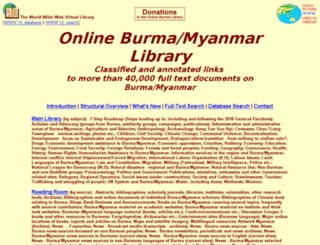Focal point
Location
The Online Burma/Myanmar Library (OBL) is a non-profit online research library mainly in English and Burmese serving academics, activists, diplomats, NGOs, CSOs, CBOs and other Burmese and international actors. It is also, of course, open to the general public. Though we provide lists of Burma/Myanmar news sources, the Library’s main content is not news but in-depth articles, reports, laws, videos and links to other websites, We provide a search engine (database and full text) and an alphabetical list of categories and sub-categories, but the Library is best accessed through browsing the 100 or so categories which lead to sub- and sub-sub categories. These tools should be used in combination.
Members:
Resources
Displaying 131 - 135 of 1151Hpapun Interview: Saw A---, January 2015
This Interview with Saw A--- describes events and issues occurring in Bu Tho Township, Hpapun District, during January 2015, including improvements in education, villager opinions about the ceasefire, and land confiscation....
The Karen Education Department (KED) said they will raise each teachers' salaries from 4,500 baht (US $133.48) to 7,500 baht (US $222.47) per year starting in 2014 in B--- village...
Land Governance Myanmar: Community Voices
Abstract: "Land is the most vital natural resource in Myanmar it is essential to livelihoods, particularly for the most vulnerable. Seventy percent (70%) of Myanmar’s population rely on land and agriculture for their livelihoods. A long history of various governing structures in Myanmar has enabled the capture and control of land by colonial, government or elite powers to the detriment and neglect of smallholder and subsistence farmers. This has impacted negatively on vulnerable populations, significantly contributing to, and shaping the current occurrence of poverty.
Press release on “With only our voice, what can we do?” Land confiscation and local response in southeast Myanmar
The Foreign Correspondents’ Club of Thailand, Bangkok - Three years after the 2012 preliminary ceasefire negotiations between the Myanmar government and the Karen National Union (KNU), reported instances of land confiscation continue to increase in southeast Myanmar. In its 2015 report, ‘With only our voices, what can we do?’, KHRG highlights four main land use types which lead to land confiscation: infrastructure projects, natural resource extraction, commercial agriculture projects, and military activities.
The International Community Must Stop Funding Gvt’s Attacks on Kachin Civilians: Moon Nay Li, General Secretary of KWAT
Moon Nay Li is the General Secretary of the Kachin Women’s Association Thailand (KWAT), an organisation which she joined in 2002 in order to work for her people and community. The KWAT was founded on September 9th 1999 in response to recognising the urgent need for women to organise themselves to help solve the growing social and economic problems in the Kachin State...The KWAT is very concerned that foreign aid and investment is serving to subsidise the government’s war machine.
Toungoo Situation Update: Thandaunggyi and Htantabin townships, November 2014 to February 2015
This Situation Update describes events and issues occurring in Thandaunggyi and Htantabin townships, Toungoo District during the period from November 2014 to February 2015, including military activity, civilians’ situation, healthcare, education, land confiscation and landmines...
In Toungoo District, the Tatmadaw are as active as they were in the past. They send their rations to the camps once every three months. On February 12th 2015, Military Operations Command (MOC) #20 was replaced by MOC #5, bringing approximately 80 military transport vehicles with them...


